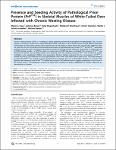Presence and seeding activity of pathological prion protein (PrP(TSE)) in skeletal muscles of white-tailed deer infected with chronic wasting disease.
Daus, Martin L.
Breyer, Johanna
Wagenführ, Katja
Wemheuer, Wiebke M.
Thomzig, Achim
Schulz-Schaeffer, Walter
Beekes, Michael
Chronic wasting disease (CWD) is a contagious, rapidly spreading transmissible spongiform encephalopathy (TSE), or prion disease, occurring in cervids such as white tailed-deer (WTD), mule deer or elk in North America. Despite efficient horizontal transmission of CWD among cervids natural transmission of the disease to other species has not yet been observed. Here, we report for the first time a direct biochemical demonstration of pathological prion protein PrPTSE and of PrPTSE-associated seeding activity, the static and dynamic biochemical markers for biological prion infectivity, respectively, in skeletal muscles of CWD-infected cervids, i. e. WTD for which no clinical signs of CWD had been recognized. The presence of PrPTSE was detected by Western- and postfixed frozen tissue blotting, while the seeding activity of PrPTSE was revealed by protein misfolding cyclic amplification (PMCA). Semi-quantitative Western blotting indicated that the concentration of PrPTSE in skeletal muscles of CWD-infected WTD was approximately 2000-10000 -fold lower than in brain tissue. Tissue-blot-analyses revealed that PrPTSE was located in muscle-associated nerve fascicles but not, in detectable amounts, in myocytes. The presence and seeding activity of PrPTSE in skeletal muscle from CWD-infected cervids suggests prevention of such tissue in the human diet as a precautionary measure for food safety, pending on further clarification of whether CWD may be transmissible to humans.
Dateien zu dieser Publikation
Keine Lizenzangabe

